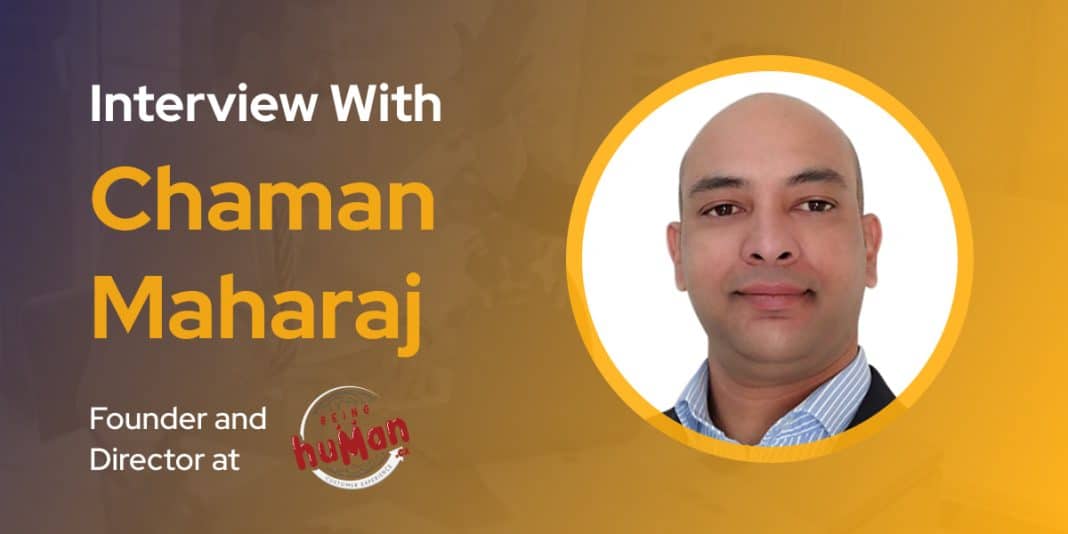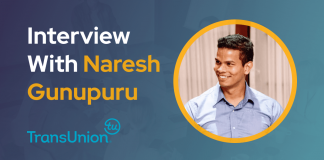Hi Chaman, tell us about yourself and your background.
My fascination with customers — their wants, needs, and expectations — began many years ago. By the time I was twelve-years old, I had grown my very own portfolio of daily, weekly, and monthly customers to exceed the magic number of our days, one hundred.
Now, I am not talking about my dad’s customers or those from our family business. You see, my dad was an architect by profession and serial entrepreneur by nature. He was not afraid to follow his passions and from it, he rightfully derived much pleasure.
He was one of ten, very resourceful siblings that grew up on the countryside in Ladysmith, in Kwa-Zulu Natal and between his brothers and sisters, they had all the necessary skills to do just about anything! From preparing the most scrumptious, traditional Indian dishes that fed scores of family members at frequent family gatherings to building complete homes from the ground up. Thereafter, there were bigger ‘gated communities’ or residential complexes and even the Moses Mabhida Stadium in Durban that was built specifically for the FIFA World Cup in 2010.
To compliment his career in architecture, it was no surprise that my dad dabbled in construction a bit, then organic, greenhouse gardening. I did however, find his decision to venture out into a fast-food restaurant/take away in the historic Victoria Street Market in Durban city centre to be a bit strange.
So, it was from a very young and tender age that I was surrounded by a variety of different customers, each with their own set of wants, needs and expectations and my customers were no different. You see, I was the bearer of news – sometimes good news and sometimes, not so good but that didn’t make much of a difference. What mattered to my customers the most was how this news was received, by them.
I was once a twelve-year old paperboy who realised the financial rewards of exceeding customer expectations.
What is the biggest misunderstanding about customer experience, in your opinion?
A question with many answers!
I speak to a variety of corporate professionals who are curious to learn more about the best ways to invest in customer experience. These audiences range from c-suite executives, to tactical, and even operational, customer-facing teams and their concerns are common, but scary.
For some odd reason, there is this general misconception that organisations need to invest billions of rands in the latest technologies, that employ world-class artificial intelligence and mega-machine learning to scale customer experience. They could not be more wrong.
Customer experience is less about technology and more about empowering employees with the necessary tools, knowledge, and skills to deliver on-brand, human-centered experiences that consistently exceed customer expectations. Customers are human beings, riddled by circumstance, emotion, and feelings – none of which can be fully understood by binary logic.
Yes, by all means – use technology to simplify and automate internal processes, use technology to empower employees with the tools required to deliver branded and differentiated experiences consistently, and use technology to enable a fluid, hassle-free customer journey and you would have only touched the surface of the customer experience iceberg.
Even the most elaborate of ‘voice of the customer’ platforms, that produce the fanciest of live, colourful dashboards do not encompass the full length and breadth of customer experience. ‘Voice of the customer’ in essence, is reactive in nature – something happens, the customer complains, the organisation either resolves a query, a symptom, or the root cause of a problem.
Customer experience is quite the opposite. Customer experience is the practice of proactively anticipating customer needs and embracing your brand values, people, products, and processes as vehicles to deliver branded and differentiated, human-centered experiences that consistently exceed customer expectations.
Customer experience starts with getting to know your customers, by understanding your brand and using that intelligence to design human-centered experiences that consistently exceed customer expectations.
I don’t think there is a piece of software out there that can do all of that!
What are some of the newer CX companies/solutions you’re keeping your eyes on right now?
Please allow me to tell your more about an incredible customer experience initiative that is currently underway in Africa. We accept that we are CX laggards, and we are doing something really special about it.
According to the CXPA website, there are exactly 1316 Certified Customer Experience Professionals or CCXPs around the globe as at the end of August 2021. Only 38 of all global CCXPs are from Africa, 28 of whom are from South Africa alone.
Multichoice, a multi-national supplier of satellite television services and Nedbank, a premier South African banking institution employ more than a quarter of all CCXPs on the African continent. Coincidentally, they have both won separate customer experience awards for their individual efforts at some of the most prestigious CX awards ceremonies around the globe.
It was clear. As a continent, to grow, to compliment, and compete with our local CX leaders, we needed to train, develop, and upskill our customer experience talent across the African continent. We needed more Certified Customer Experience Professionals in Africa.
So, we established a non-profit-company, AFRICANISM | CX as a customer experience training and social development initiative. We have partnered with the legendary Ian Golding, a Customer Experience Professionals Association accredited ‘Recognised Training Provider’ to bring world-class customer experience training to CX enthusiasts across to the African continent.
We have just announced the winners of our #ThreeFreeSeats campaign for Women’s month and three lucky ladies, from Kenya, Ghana, and South Africa respectively, will be attending Ian Golding’s two-day CX Masterclass and CCXP Exam Prep workshops this September. These local CX enthusiasts will embark on an exciting, CX learning journey that goes beyond CCXP certification, and into their professional capacities with guidance on delivering demonstrable customer experience improvements within their respective areas of work. These are our next generation of CX mentors.
We are really excited about this initiative. We would like to train seven more delegates before the end of the year, and we have longer term aspirations of reaching 100 Certified Customer Experience Professionals in Africa before the end of 2023.
As our network of sponsors grow, we will be able to train more CX enthusiasts from across the African continent, quicker and for anyone that may be interested in learning more about AFRICANISM | CX, please go to africanism.org.za or email us on hello@africanism.org.za.
What can companies do to improve customer loyalty and retention?
Don’t rely on a piece of software to fix your customer experience problems. You would be setting yourself, your organisation, and more importantly, your customers up for failure.
Instead, get to know your customers, understand your brand, and use that intelligence to design human-centered experiences that consistently exceed customer expectations.
What do you think is most relevant and why: CSAT (customer satisfaction score), NPS (net promoter score), or CES (customer effort score)?
A topic of much debate!
They are all still very relevant, equally important and should be used for no other reason than to drive demonstrable CX improvements within an organisation.
Customer Satisfaction Score is still a great measure for simple, automated, customer interactions – such as asking a chat-bot an easy question. This interaction either meets your customers need, or not. Even though Customer Satisfaction Score has been around for more than twenty-years, it still has a place in our modern, customer experience ecosystems and the insights derived from it can be equally important to those from Net Promoter System or Customer Effort Score. What’s really important here is to use the right customer experience metric to measure the right type of customer interactions.
Net Promoter Score has recently been appropriately renamed to ‘Net Promoter System’ which focuses less on the actual score and instead, promotes using a closed-loop feedback mechanism to drive CX improvements within an organisation, resulting in improved NPS scores. So the NPS goal posts have shifted – Net Promoter Score was once a destination and now, the inclusion of the closed-loop feedback system makes the Net Promoter System more of a journey. I like to use this probe on likelihood to recommend at the end of a customer journey, when the customer is either most likely to achieve a brand specific goal, or not.
Now, Customer Effort Score is special – particularly in the post-Covid19 world of ecommerce. Customer Effort Score measures how easy or difficult it is for your customers to transact with you or achieve a brand specific outcome, often within a specific customer journey – such as checking-in at the airport for a booked holiday flight.
In this case, the customer journey would have begun long before the flights were booked. It may have started with determining a destination, choosing the best way to get there, choosing what to do when you’re there, when you would be returning, and so on. Checking-in is a component, it is one of many points of customer interaction within this customer journey.
Checking -in can be done either in-person or online these days and there are simple and effective ways to measure and optimise these individual processes such as average queueing time at the airport, or the number of online clicks. Make it as easy for your customers as possible, to achieve these little milestones and the broader customer journey inevitably emerges pain-free.
How can companies better use social media in the era of customer-centricity and personalization?
I am a big fan of establishing listening posts across social media platforms, to really get to know your customers, to connect with them on a personal level, and to learn more about them as individuals.
Don’t be afraid to celebrate your customer’s victories and support them through their challenges. Understand their attitudes, behaviours, and reasons for which they connect with their favourite brands. Use this data to predict your customer’s wants, needs, and expectations and deliver targeted products and services to specific customers in need. That’s what personalisation is all about!
To the organisations who prefer only to use this data for those cold, generic and unsolicited sales emails, how’s that going for you?
What is your opinion on AI-based chatbots to handle customer support?
I have yet to have a successful customer interaction with a chatbot!
Bots need training, they can learn, and need to be taught. Much like new employees, chat-bots are often entrusted with responsibilities that they are not empowered enough to execute on, resulting only in customer frustration.
Test your chat-bots thoroughly before they’re deployed. Bring cross-functional teams together and be sure to also get customers involved in the testing process. Observe customer comfort levels as they engage with your technology and eliminate all friction-points as soon as possible.
What was the best movie you saw that has come out during this past year?
“My Octopus Teacher” — a local, South African production shot off the coast of Cape Town, featuring a passionate filmmaker and his incredible connection with a curious sea-creature. It has an engaging storyline and has won “Best Documentary Feature” at this year’s Academy Awards so it’s definitely worth catching if you’re into that sort of thing.
Last but not least, what is your favorite CX metric?
That’s an easy one: Customer Effort Score for sure.
Chaman Maharaj is the Founder and Director at Being Human, a human-centered Customer Experience advisory in South Africa – a global thought leader on Customer Experience, a Customer Experience Specialist (CXS)™, Certified Customer Experience Professional (CCXP)™, author, blogger, and contributor on cxpa.org, customerthink.com, mycustomer.com, and cxm.co.uk, and volunteer at AFRICANISM | CX.






